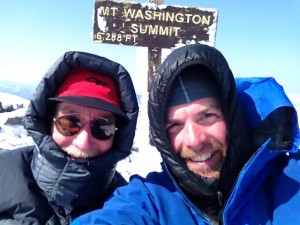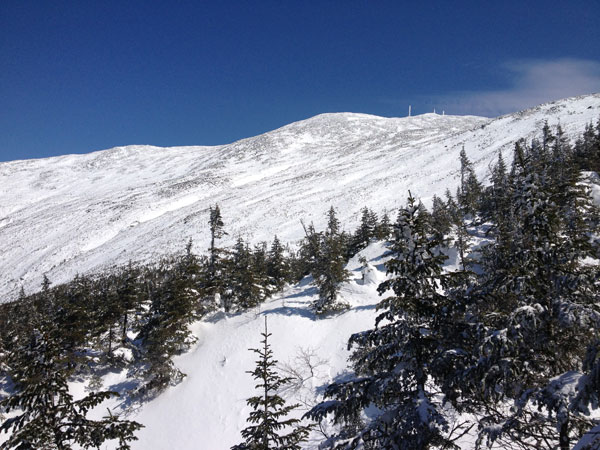It is one week until we head out to Greenland. Spring has finally arrived in Milton. As I write, crocuses are in bloom and the tulips in my yard are pushing up. But in Illulisat, Greenland it is 5°F, and that is at sea-level (our field sites will all be considerably higher). The highest the temperature will get there this coming week is 37°F with several days that won’t get above 10°F.
In those kinds of temperatures what you wear and how you wear it can make all the difference between a pleasurable (or at least tolerable) day outdoors and a freezing suffer-fest. For the past several winter months I have been trying to get ready for long days in the field in Greenland by spending as much time out in the cold as possible. Winter hiking, ice climbing, cross country and downhill skiing, and even dog walking in the cold are all things that I enjoy doing already, but this winter I tried to ramp up my activity more than usual. My plan was to acclimate myself to the cold and also to test out various clothing “systems.” From 20+ years of time spent in the outdoors I have acquired several options for base-layers, fleece, down, and shell jackets, and gloves, mittens, and hats. Even with all that gear I always seem to have trouble keeping my hands and feet warm so I wanted to really test which combinations of all these options would be most likely to keep me warm while in Greenland.
You will see from my Instagram (hit the “camera” icon on the right of each page) that I wrapped up winter (ironically during Spring Vacation) with some snowy adventures. The last week of break I got the chance to really put my “training” to the test. My friend Tom had hiked all of New Hampshire’s peaks over 4000 feet (there are 48 in total) except for Mt. Washington, the biggest and the baddest of them all.
Mt. Washington has a weather observatory on top and, in the summer, you can access the summit by car or the Cog Railroad. Tom hasn’t loved the idea of going to summit in the summer; there is something disheartening about hiking to the top only to find a bunch of people who drove or took the train. So I convinced him that a winter ascent was the way to go!
We made it to the top on March 27 under sunny skies but it was below freezing. There were also strong winds (50-60 mph) over the summit so it was well below zero with the wind chill-basically full-on winter conditions!
I learned several things that should help in Greenland. I already knew the value of layering with synthetic (non-cotton) clothes and I got the system just right this time. On the bottom: mid-weight long underwear bottoms with Polartec 100 fleece pants and a shell bibs. My bibs are shorter (they don’t completely cover the chest) but they allow you tuck your upper layers into the pants without them coming untucked. This conserves a lot of heat that would otherwise potentially leak out when layers get untucked from pants. On top: a mid-weight long underwear top and a Patagonia R2 fleece. I found this combo to be warm and breathable but completely lacking in wind-proofness, so when we got above treeline I added a Patagonia Nano-Puff insulation layer and a 3 layer Goretex shell and I was toasty warm the rest of the day. I never even had to go for the “big-dog,” my 800 fill goose down parka, which stayed in its stuff sack in my pack. While these layers worked well, what really made the difference were four things-liner gloves, a snug balaclava, hoods, and goggles.
 As I said, my hands always get cold, even with my biggest mittens. A new addition to my quiver this time out was Minus 33 brand merino wool liner gloves inside my big Black Diamond Mercury mitts. When needed, I was able to take off the big mitts and still be warm in the gloves. I even took the gloves partially off to run the camera on my iPhone. I had also just purchased a snug fitting balaclava that covered most of my face from Ragged Mountain in North Conway, NH. I then put up the hood on my Patagonia Nano-Puff (a super light-weight insulated jacket) and then the ski goggles over the hood. Finally I put up the hood of my shell jacket and cinched it down tight so the wind could not blow it off. With the balaclava, hoods, and goggles, only the tip of my nose was exposed and even that could be covered with the balaclava. The goggles were especially key because they allowed for great vision and a surprising amount of warmth, not to mention that they acted as sunglasses on a bright day.
As I said, my hands always get cold, even with my biggest mittens. A new addition to my quiver this time out was Minus 33 brand merino wool liner gloves inside my big Black Diamond Mercury mitts. When needed, I was able to take off the big mitts and still be warm in the gloves. I even took the gloves partially off to run the camera on my iPhone. I had also just purchased a snug fitting balaclava that covered most of my face from Ragged Mountain in North Conway, NH. I then put up the hood on my Patagonia Nano-Puff (a super light-weight insulated jacket) and then the ski goggles over the hood. Finally I put up the hood of my shell jacket and cinched it down tight so the wind could not blow it off. With the balaclava, hoods, and goggles, only the tip of my nose was exposed and even that could be covered with the balaclava. The goggles were especially key because they allowed for great vision and a surprising amount of warmth, not to mention that they acted as sunglasses on a bright day.
With this combo of clothing, I never got cold once all day-probably a first for me! So now I have a better idea how to dress in Greenland. If you are venturing into the outdoors, remember that layers of non-cotton long underwear and fleece along with hooded wind-proof jackets will keep your heat in and the cold wind out!



 FOLLOW US ON TWITTER
FOLLOW US ON TWITTER